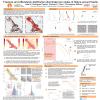Poster #142, Fault and Rupture Mechanics (FARM)
The influence of lithology and preexisting damage on brittle fragmentation during dynamic tensile loading
Poster Image:

Poster Presentation
2020 SCEC Annual Meeting, Poster #142, SCEC Contribution #10426 VIEW PDF
Simulations of subshear rupture propagation on bimaterial fault interfaces show that a state of isotropic tension, exceeding the tensile strength of most rocks, is produced at distances up to 100 m from the fault, potentially explaining field observations of broad swaths of pulverized rocks adjacent to major strike-slip faults in southern California. However, direct application of rupture simulations to natural faults is difficult because little experimental data exists to constrain the influence of lithology and preexisting damage on brittle fracture during dynamic (i.e., at strain rates exceeding ~100 s-1) tensile loading. We investigate the influence of these properties on coseismic tensile fragmentation using a modified sample configuration for a Split Hopkinson Pressure Bar consisting of a rock disk bonded to two outer lead disks. Axial loading produces radial strain in the lead disks which in turn apply isotropic tension on the rock sample. We test the lithological controls on fragmentation (e.g., fragment size and distribution) and fracture density through experiments on sandstone and granite. The nature of fractures produced during tensile loading in sandstone is fundamentally different than granite. Whereas sandstone fractures propagate by grain boundary failure, granite fails through a combination of inter- and intragranular fracturing. We examined the influence of preexisting damage on the evolution of fracture density in sandstone through testing samples heat-treated at 250, 450, 650, and 850 °C, and we compare the results of these tests to similar experimental results on Westerly Granite. The tensile strength of Berea Sandstone increases between room temperature experiments and those treated at 250 °C and then steadily deceases for samples treated at higher temperatures. Above treatment temperatures of 450 °C, significant mineralogical and mechanical (e.g., microfracturing) changes result in an overall weakened state. We examine the implications of this strength reduction on the corresponding fragment size populations. Our results highlight the role of lithology and pre-existing damage on the spatial extent of pulverized and dynamically fractured fault damage zones and elucidate potential geologic fingerprints of dynamic rupture.


























































